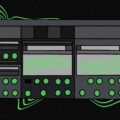There comes a pivotal point in the career of many Canadian artists when they’re ready to take the leap (literally and figuratively) over to the American market. For emerging musicians looking to showcase their talent and connect with a broader international audience, the U.S. holds a whole new world of exciting opportunities. But before you get too eager to hit those big stages south of the border – legally – you’ll need to secure the appropriate work permit.
Our handy how-to guide will focus on two popular first-time visa options for Canadian artists, the 0-1 and P-2 visas, and include testimonials from musicians who’ve secured the permits about their experiences. In this first part of our series, we’ll examine all the costs, requirements, and timelines involved in applying for the P-2 visa. Follow along to get one step closer to understanding and securing the right visa for you, and to be prepared for any potential challenges that might come up along the way.
P-2 Visa: Reciprocal Exchange Program
Canadian artists applying to work and perform in the U.S. as their career is rising have a number of work permits to choose from. All serve artists, but they cater to different circumstances, so it’s important to understand the differences to choose the right one for your current situation.
One of the most common options is the P-2 Visa (Individual Performer or Part of a Group Entering to Perform Under a Reciprocal Exchange Program). According to the United States Citizenship and Immigration Services (USCIS): “The P-2 classification applies to you if you are coming temporarily to perform as an artist or entertainer, individually or as part of a group, who will perform under a reciprocal exchange program between an organization in the United States and an organization in another country.”
Put more simply, the P-2 is a nonimmigrant visa that allows artists to be employed in the U.S. if they’re invited by an American employer to work in the entertainment industry (music, dance, theater, etc.) To apply, you need to prove two things. First, you need a job offer from a specific employer, and that employer must have the green light from the Secretary of Labor for your job. Second, you need to provide proof that you’re qualified to work in your field.
To read more about tour planning, check out our series on Your First Big Tour: How to Plan, Pack, and Prepare
Application Process and Duration of Stay
To get started, your sponsoring US employer or organization needs to file Form I-129, Petition for a Non-Immigrant Worker, with supporting documents outlining the exchange program.
The Total Law Global Immigration Attorneys website states that “along with Form I-129, you must include the following documents in your application for the P-2 Visa Petition:
- A written consultation with a local labor organization
- A copy of the formal reciprocal exchange agreement between the U.S. organization(s) sponsoring the artist or entertainer and the foreign organization(s) which will receive them
- A statement from the sponsoring organization describing how the reciprocal exchange of United States artists or entertainers will benefit or otherwise affect the specific petition for which classification is sought
- Evidence that you and the U.S. artist or entertainer subject to the reciprocal exchange agreement are professionals with comparable skills, and that your terms and conditions of employment are similar
- Evidence that an appropriate labor organization in the United States was involved in negotiating, or has concurred with, the exchange of artists and entertainers between the U.S. and foreign countries
- A schedule of performances, including dates and locations if the events or performances will take place in multiple areas like on a tour”
For more information on applying for the P-2 visa, see the official USCIS government website.
After arriving in the States, artists can stay for up to one year in the initial period of the P-2 work visa, which is the allotted time to complete the event, performance, or competition. It is possible to extend stay in increments of up to one year, if more time is needed to continue or complete the exchange program or performance engagement.
The application to extend your stay in the States involves filing another form, Form I-539, with the USCIS before your initial one-year stay expires. Artists be careful : if you overstay your authorized visa, you could be banned from returning to the U.S. and deported. We don’t want you taking any chances!
Your petition for an extension will also require further documentation, including a letter to describe employment, your last two pay stubs, and most recent W-2 form, so make sure to start the process early to give yourself more than enough time to apply before your P-2 expires.
Costs and Processing Time
As much as it would be fantastic to hop down south and easily perform whenever we want (for free), work visas can rack up an expensive bill (especially for struggling young artists). Thankfully, the initial filing fee for the P-2 visa is relatively budget-friendly compared to other work permits.
The regular visa processing fee is $460 USD to file your Form I-129. As outlined on the Canadian Federation of Musicians (CFM) site, to pay “you may use a money order, personal check, or cashier’s check. You can also pay with a credit card by filling out Form G-1450 Authorization for Credit Card Transactions. When paying by check, be sure to make it out to the U.S. Department of Homeland Security (DHS).”
The regular processing time can take up to 90 days, so it’s recommended to submit your application at least three months before your first gig. If the DHS is swamped with applications, or if you’re flagged for additional screening for any security concerns, it could slow down the processing period. Remember that the sooner your U.S. employer can also submit supporting documents, the better, so that the DHS can begin reviewing as soon as they receive your application.
There are ways to expedite the process if you have some savings in the bank. Premium processing comes with a $2,500 USD fee, but it allows you to submit your P-2 application only 25 calendar days prior to your first engagement. *Note that premium processing still requires the initial $460 USD amount, on top of the other $2,500 USD fee, paid in two separate money orders to the DHS.
Though it isn’t mandatory to hire an attorney, it can be beneficial to set aside additional money for legal fees if you’re applying for your P-2 visa for the first time and need further guidance. Though the process may seem daunting, remember that many young artists have successfully navigated the immigration system and secured visas that have opened the door to new career opportunities, collaborations, and fans (and that you have a whole community around you who can offer advice and support)!
Stay tuned for part 2 of our series on US Work Permits for Canadian Artists: a Guide to the O-1 Visa for Individuals with Extraordinary Ability or Achievement.
Written by Maryse Bernard
Illustration by Yihong Guo






















